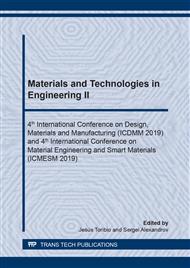[1]
Y. Yao, X. D. Fang, et G. Arndt, «On-Line Estimation of Groove Wear in the Minor Cutting Edge for Finish Machining», CIRP Ann., vol. 40, no 1, p.41‑44, (1991).
DOI: 10.1016/s0007-8506(07)61929-5
Google Scholar
[2]
Z. Vagnorius et K. Sorby, «Estimation of cutting tool failure costs », in 2009 IEEE International Conference on Industrial Engineering and Engineering Management, 2009, p.262‑266.
DOI: 10.1109/ieem.2009.5373366
Google Scholar
[3]
«ISO 3685:1993 - Tool-life testing with single-point turning tools.» (1993).
Google Scholar
[4]
G. T. Smith, Cutting Tool Technology. London: Springer London, (2008).
Google Scholar
[5]
Y. Altintas, Manufacturing automation. Cambridge University Press, (2012).
Google Scholar
[6]
W. Rmili, A. Ouahabi, R. Serra, et R. Leroy, «An automatic system based on vibratory analysis for cutting tool wear monitoring», Measurement, vol. 77, p.117‑123, janv. (2016).
DOI: 10.1016/j.measurement.2015.09.010
Google Scholar
[7]
A. E. Diniz, J. J. Liu, et D. A. Dornfeld, «Correlating tool life, tool wear and surface roughness by monitoring acoustic emission in finish turning», Wear, vol. 152, no 2, p.395‑407, (1992).
DOI: 10.1016/0043-1648(92)90135-u
Google Scholar
[8]
G. P. Petropoulos, C. N. Pandazaras, et J. P. Davim, «Surface Texture Characterization and Evaluation Related to Machining», in Surface Integrity in Machining, J. P. Davim, Éd. London: Springer London, 2010, p.37‑66.
DOI: 10.1007/978-1-84882-874-2_2
Google Scholar
[9]
D. A. Stephenson et J. S. Agapiou, Metal Cutting Theory and Practice, 3e éd. Boca Raton: CRC Press, Taylor & Francis, (2016).
Google Scholar
[10]
P. G. Benardos et G.-C. Vosniakos, « Predicting surface roughness in machining: a review », Int. J. Mach. Tools Manuf., vol. 43, no 8, p.833‑844, (2003).
DOI: 10.1016/s0890-6955(03)00059-2
Google Scholar
[11]
W. Grzesik, « Influence of tool wear on surface roughness in hard turning using differently shaped ceramic tools », Wear, vol. 265, no 3‑4, p.327‑335, (2008).
DOI: 10.1016/j.wear.2007.11.001
Google Scholar
[12]
C. Lu, N. Ma, Z. Chen, et J.-P. Costes, « Pre-evaluation on surface profile in turning process based on cutting parameters », Int. J. Adv. Manuf. Technol., vol. 49, no 5‑8, p.447‑458, (2010).
DOI: 10.1007/s00170-009-2417-9
Google Scholar
[13]
T. Özel et Y. Karpat, « Predictive modeling of surface roughness and tool wear in hard turning using regression and neural networks », Int. J. Mach. Tools Manuf., vol. 45, no 4‑5, p.467‑479, (2005).
DOI: 10.1016/j.ijmachtools.2004.09.007
Google Scholar
[14]
L. Equeter, C. Letot, R. Serra, et P. Dehombreux, « Estimate of Cutting Tool Lifespan through Cox Proportional Hazards Model », IFAC-PapersOnLine, vol. 49, no 28, p.238‑243, (2016).
DOI: 10.1016/j.ifacol.2016.11.041
Google Scholar
[15]
L. Wang, M. G. Mehrabi, et E. Kannatey-Asibu, « Hidden Markov Model-based Tool Wear Monitoring in Turning», J. Manuf. Sci. Eng., vol. 124, no 3, p.651, (2002).
DOI: 10.1115/1.1475320
Google Scholar
[16]
V. P. Astakhov, « The assessment of cutting tool wear », Int. J. Mach. Tools Manuf., vol. 44, no 6, p.637‑647, (2004).
Google Scholar
[17]
A. Siddhpura et R. Paurobally, «A review of flank wear prediction methods for tool condition monitoring in a turning process», Int. J. Adv. Manuf. Technol., vol. 65, no 1‑4, p.371‑393, (2013).
DOI: 10.1007/s00170-012-4177-1
Google Scholar
[18]
P. J. Arrazola, A. Garay, E. Fernandez, et K. Ostolaza, «Correlation between tool flank wear, force signals and surface integrity when turning bars of Inconel 718 in finishing conditions », Int. J. Mach. Mach. Mater., vol. 15, no 1/2, p.84, (2014).
DOI: 10.1504/ijmmm.2014.059193
Google Scholar
[19]
R. M. Sundaram et B. K. Lambert, « Surface roughness variability of AISI 4140 steel in fine turning using carbide tools », Int. J. Prod. Res., vol. 17, no 3, p.249‑258, (1979).
DOI: 10.1080/00207547908919612
Google Scholar
[20]
V. P. Astakhov et J. P. Davim, « Tools (Geometry and Material) and Tool Wear », in Machining - Fundamentals and Recent Advances, Springer-V., J. P. Davim, Éd. London: Springer London, 2008, p.29‑57.
DOI: 10.1007/978-1-84800-213-5_2
Google Scholar
[21]
Seco Tools, Turning catalog and technical guide, 2e éd. SECO TOOLS AB, (2018).
Google Scholar
[22]
F. Klocke, Manufacturing Processes 1. Berlin, Heidelberg: Springer Berlin Heidelberg, (2011).
Google Scholar
[23]
M. E. R. Bonifacio et A. E. Diniz, «Correlating tool wear, tool life, surface roughness and tool vibration in finish turning with coated carbide tools», Wear, vol. 173, no 1‑2, p.137‑144, (1994).
DOI: 10.1016/0043-1648(94)90266-6
Google Scholar


